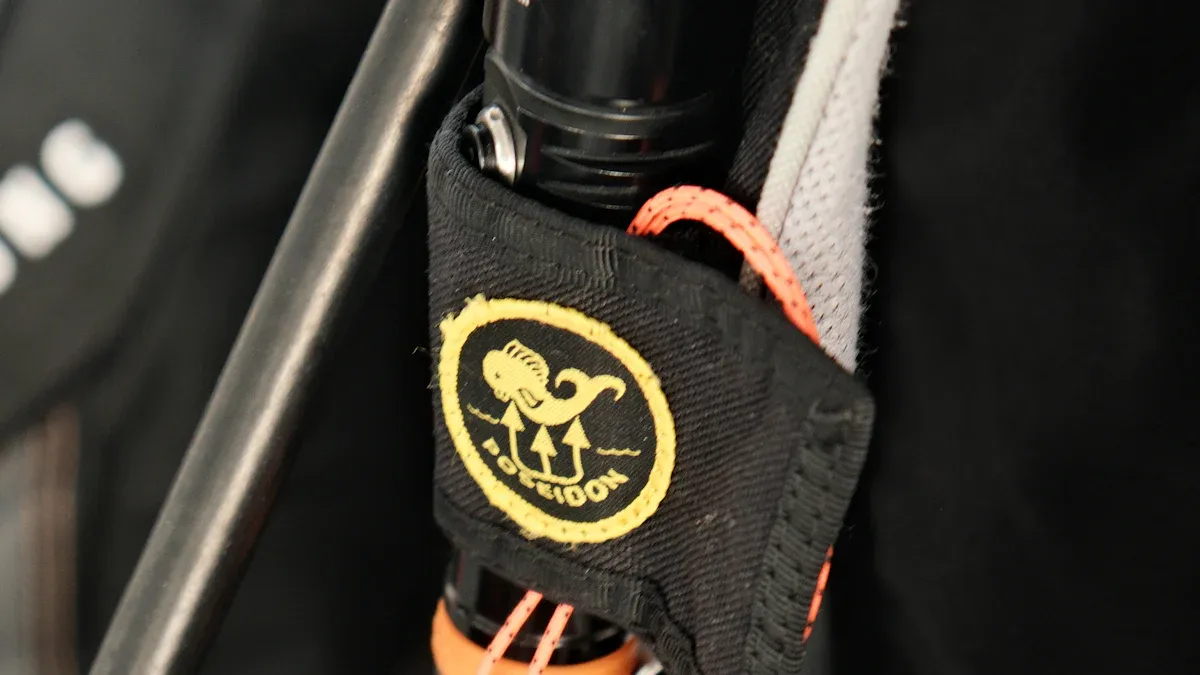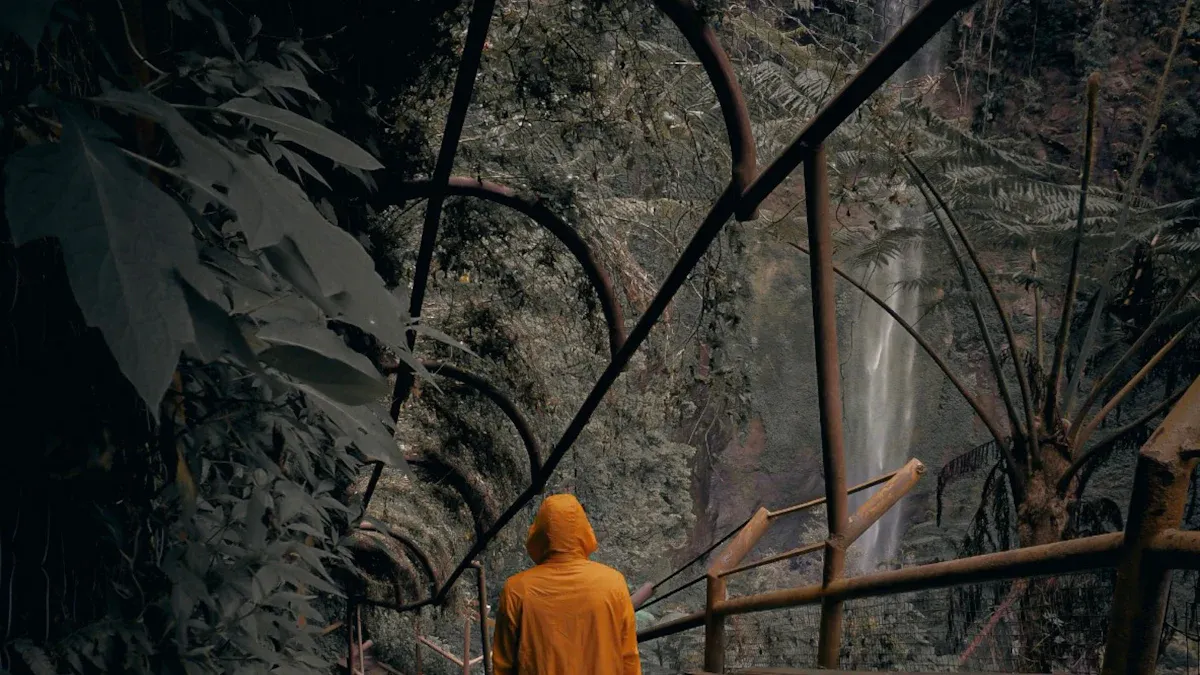The Role of Flashlights in Enhancing Safety for Nighttime Hiking

Nighttime hiking presents unique challenges that demand preparation. A flashlight ensures you stay safe by illuminating your path and helping you avoid common hazards. These include tripping over roots or rocks, missing trail markers, or encountering wildlife. With proper lighting, you can confidently navigate trails and respond to unexpected situations.
Key Takeaways
Pick a flashlight with 200-400 lumens for clear trail views.
Use a light and strong flashlight for comfort and safety.
Bring extra lights, like a headlamp or batteries, for emergencies.
Why Flashlights Are Essential for Nighttime Hiking

Enhancing Visibility on Trails
A flashlight is your most reliable light source when hiking at night. It ensures you can see the trail clearly, even in complete darkness. Uneven terrain, tree roots, and rocks become visible, reducing the risk of tripping or falling. Without proper lighting, distinguishing flat ground from uneven surfaces becomes challenging. A torch provides the visibility you need to navigate safely and confidently.
Preventing Disorientation and Aiding Navigation
Nighttime hiking often involves poorly marked trails or paths that look similar. A flashlight helps you identify trail markers, signs, and landmarks. This prevents you from losing your way and ensures you stay on the correct path. If you carry a torch with a focused beam, it can illuminate distant objects, making navigation easier. A reliable light source is essential for hiking in unfamiliar areas.
Spotting and Avoiding Hazards
Hiking in the dark exposes you to various hazards. A flashlight allows you to spot obstacles like snakes, protruding roots, or hidden pits. It also helps you avoid uneven terrain that could cause injuries. By illuminating your surroundings, a torch keeps you aware of potential dangers and ensures your safety.
Providing Emergency Illumination
Emergencies can happen unexpectedly during nighttime hiking. A flashlight becomes a critical tool in such situations. You can use it to signal for help if you get separated from your group. Its beam can attract attention and guide rescuers to your location. A torch also provides light for first aid or other emergency tasks, ensuring you stay prepared for any situation.
Features to Consider When Choosing a Flashlight
Brightness and Beam Distance
When selecting a flashlight for nighttime hiking, brightness and beam distance are critical factors. A flashlight with at least 500 lumens ensures sufficient illumination in dark conditions. The beam distance determines how far ahead you can see, which is vital for spotting obstacles or trail markers. The table below provides a guide to choosing the right brightness and beam distance for your needs:
Lumens | Distance | Best For |
|---|---|---|
1–250 | Up to 80 meters | Everyday and leisure activities in dim conditions |
160–400 | Up to 100 meters | Camping, hiking, backpacking |
400–1000 | Up to 200 meters | Hiking, backpacking, caving, campervan engine repair |
1000–3000 | Up to 350 meters | Fishing, hunting, rock climbing |
3000–7000 | Up to 500 meters | Extreme weather conditions, mountaineering, emergency rescue |
Battery Life and Rechargeability
Battery life directly impacts the reliability of your flashlight during extended hikes. Long runtimes in eco or low modes prevent your flashlight from dying unexpectedly. Some models can last up to 200 hours in low mode, ensuring you stay prepared for multi-day adventures. Rechargeable flashlights are also a sustainable option, reducing the need for disposable batteries.
Durability and Weather Resistance
Durability is essential for outdoor gear. Look for flashlights made from high-quality aluminum or reinforced plastic. Rubberized seals or O-rings protect against water and dust ingress. The IP rating system helps you assess weather resistance. For example:
IP65: Water-resistant against low-pressure water jets.
IP67: Submersible in up to 1 meter of water for 30 minutes.
IP68: Dustproof and capable of continuous submersion in deeper water.
Portability and Weight
A lightweight flashlight is indispensable for hikers. Compact designs are easy to pack and won’t add unnecessary weight to your gear. Lightweight models also consume less battery power, making them more energy-efficient. Versatile light modes further enhance their usability for various outdoor scenarios.
Additional Features for Night Hiking
Modern flashlights often include features tailored for nighttime hiking. Red light modes preserve your night vision while providing sufficient illumination. SOS and flashing modes are useful for emergencies. LED technology ensures energy efficiency, allowing your flashlight to last longer during extended hikes.
Practical Tips for Using Flashlights During Night Hiking

Carrying Backup Lighting Options
Always carry a backup flashlight or an additional light source during nighttime hikes. This ensures you remain prepared if your primary flashlight malfunctions or its battery depletes unexpectedly. Compact flashlights or small headlamps serve as excellent secondary options. You can also consider lightweight keychain lights for emergencies. Having multiple light sources enhances your safety and ensures you are never left in the dark.
Maximizing Battery Efficiency
Efficient battery usage extends the runtime of your flashlight, especially during long hikes. Use lower brightness settings when full illumination is unnecessary. Turn off the flashlight during breaks to conserve power. Rechargeable batteries are a sustainable choice, but always ensure they are fully charged before your hike. Carry spare batteries to avoid being caught unprepared.
Maintaining and Cleaning Your Flashlight
Proper maintenance ensures your flashlight performs optimally. Follow these steps to clean and care for it:
Dip a soft cloth in a cleaning solution and gently wipe the exterior.
Rinse with clean water and dry thoroughly.
Inspect battery contacts for corrosion and clean them if needed.
Lubricate threads and o-rings to maintain smooth operation.
Regularly check seals for damage and replace them if necessary.
Avoid dropping or shaking your flashlight, as this can damage internal components. Conduct monthly check-ups to ensure all parts function correctly.
Using Headlamps for Hands-Free Lighting
A headlamp offers unparalleled convenience by keeping your hands free during nighttime hikes. This allows you to focus on climbing, hauling gear, or navigating steep slopes without holding a flashlight. While headlamps may have slightly lower brightness and battery life, they provide excellent flexibility and freedom of movement. This makes them an ideal choice for hikers who want to fully immerse themselves in their surroundings.
Practicing Responsible Lighting to Protect Wildlife
Artificial lighting can disrupt the nocturnal environment, affecting wildlife behavior and ecosystem balance. Use low-intensity lighting and minimize its use to reduce disturbances. Avoid shining your flashlight directly at animals or sensitive habitats. In areas with high ecological sensitivity, consider using a red light mode, which is less likely to disturb wildlife. Responsible lighting practices not only protect animals but also preserve the natural beauty of the environment.
Flashlights play a vital role in ensuring your safety and enjoyment during nighttime hikes. Selecting the right flashlight and using it effectively can make all the difference. Keep these key takeaways in mind:
Opt for a flashlight with at least 200-400 lumens for hiking.
Choose a durable, lightweight design for comfort and reliability.
Ensure it is waterproof (minimum IPX4) to handle unpredictable weather.
To maximize safety:
Use a flashlight with a red-light setting to preserve night vision.
Familiarize yourself with its settings before heading out.
Always prepare for emergencies by carrying spare batteries or a power bank.
Investing in a reliable flashlight and following these tips ensures you stay visible, safe, and ready for any situation.
FAQ
What type of flashlight is best for hiking?
Choose a durable, lightweight flashlight with at least 200 lumens. Ensure it has long battery life, weather resistance, and features like red-light mode for nighttime hiking.
How can you extend flashlight battery life during hiking?
Use lower brightness settings and turn off the flashlight during breaks. Fully charge rechargeable batteries before your hike and carry spares for emergencies.
Should you use a headlamp or handheld flashlight for hiking?
Headlamps offer hands-free convenience, making them ideal for climbing or navigating. Handheld flashlights provide higher brightness and beam control, which is useful for spotting distant hazards.
See Also
Why Hunting Flashlights Are Crucial For Outdoor Adventures
Camping Essentials: Choosing Between Lanterns And Flashlights
How To Select The Perfect Flashlight For Hiking Trips
